Pool owners are responsible for restricting access by young children to residential pools.
From 2017, the Fencing of Swimming Pools Act is no longer in effect. The legislation relating to pool barriers and pool fencing is now the Building Act 2004.
See Building Code Clause F9 - Restricting access to residential pools
A pool is defined in the Act as an excavation, structure, or product that's used or capable of being used for swimming, paddling or bathing, including spa pools, with a depth of 400mm or more.
To apply for consent
- Complete the Swimming Pool / Safety Barrier application form and attach: A certificate of title, no older than 3 months. If you don't have one, we can get this for you for a small fee.
- A site plan that shows the street location, distance to boundaries and buildings, natural features of the land including hills, lakes, streams, trees etc and detail of any excavation work or site levelling.
- For rural areas - you need to show the location of the septic tank and effluent lines.
- A set of plans (1:100 minimum scale) it must include barrier detail, location, height, gates and latches. If the house is part of the barrier, then doors and windows into the pool area must be shown.
- If the application is for an existing safety barrier - attach photos that clearly show all the details.
- Specifications - details of compliance with Building (Pools) Amendment Act 2016.
- Pay the deposit fee.
The terms pool barrier and pool fence are interchangeable. Previous legislation referred to ‘pool fences’ now the current Building Act uses the term ‘pool barrier’.
They are both structures to prevent access to pools by children under 5-years-of-age.
Barriers are required for all 'residential pools' that can be filled to a depth of 400mm or more and contain water, regardless of the amount of water.
Residential and Pool are defined as:
Residential relates to a place of residence, including hotels, motels and similar accommodation.
Pool relates to any type of excavation or structure that's used for swimming, paddling or bathing.
A residential pool barrier is not required for garden ponds and similar water hazards, which are not intended to fall within the definition of pool.
Building work for a residential pool requires a building consent, unless it's exempt under Schedule 1 of the Act.
Obtain a building consent before installing a pool and when adding or altering a fence around a pool.
All pools must be fenced, regardless of when they were installed.
An existing pool that's not fenced to the standards in the Act will require a building consent.
Pools below certain volume thresholds are exempt under the Act - see Clause 23 of Schedule 1.
Even if the building work for a residential pool is exempt, the owner must still obtain a building consent for the barrier.
This confirms from the outset that the pool has barriers that restrict the access of young children, and informs the Council of the location of the pool.
A small heated pool (spa pool) may be exempt from requiring a fence, and therefore a building consent, so long as the cover, and the pool, meet the set safety standards. See the specific comment on spa pools later in this document.
Temporary residential pools, such as inflatable pools, are subject to the same Building Code fencing requirements as other residential pools.
The pool’s barrier must comply with all the relevant requirements of the Building Code. For example, any gates in the pool’s barrier, including doors and windows of a house, must be self-closing, and the barrier must meet the requirements in the Building Code for structure and durability.
Any pool that cannot be filled to a depth of 400mm does not require a barrier.
The law exists to protect young children under 5 from the dangers of swimming pools.
Any person who owns or uses and unfenced pool commits an offence under the Act and may be prosecuted. Criminal charges can be brought against any person in control of a property where a child drowns due to an inadequately fenced or maintained pool fence, whether consented or not.
Pools installed and consented:
- Before 1 January 2017 are required to be fenced in compliance with the Schedule of the Fencing of Swimming Pools Act 1987.
- After 1 January 2017 must comply with clause F9/AS1 Building Code - Means of restricting access to residential pools
and/or Acceptable Solution F9/AS2 Covers for small heated pools
A quote from Dr Ian Hassall, Director of Medical Services for the Plunket Society
“80% of children that drown in pools are children of the owners or their invited guests, so this law is really to save your own loved ones”.
All pools, if not exempt, require a building consent for the fence or barrier that surrounds the pool.
Pool owners and anyone with a pool on their property including tenants, have duties under the Act.
The following persons must ensure a pool barrier complies:
- The owner of the pool
- The pool operator
- The owner of the land the pool is on
- The occupier of the property the pool is on
- If the pool is available for hire, the person who is hiring the pool
- If the pool is on premises that are not subject to a tenancy (under the Residential Tenancies Act 1986) but the pool is subject to a lease or is part of premises subject to a lease, the lessee of the pool or the premises).
Pool owners must tell Council that they have a pool on their property.
Inspections every 3 years
Councils are required to ensure that consented residential pools are inspected every 3-years to check that they continue to comply with the Act.
An inspection is required every third anniversary of when the pool received its code compliance certificate. The inspection may occur any time before the anniversary.
These inspections do not apply to small heated pools, if a compliant safety cover is used as the pool barrier.
How we notify you and what we inspect
The inspection includes
* the barrier height and that no climbable objects are nearby
* any gates, doors or windows opening into the pool area
* the boundary fence that forms part of the pool barrier.
We'll send a letter to the pool owner before the scheduled inspection. A checklist is attached to help you with compliance. A fee applies for each inspection and any re-inspections.
If during re-inspection, any of the items are found to be non-compliant, a Notice to Fix identifying the problem area will be issued. Any failure to comply with a Notice to Fix will result in an instant $500 infringement fine.
The owner/occupier should carry out regular ongoing checks and maintenance to make sure the pool barrier continues to meet the required standards
Pool barrier - fence requirements
The fence must be made of durable materials and constructed to prevent children under the age of 5-years from gaining access to the pool.
Fence height
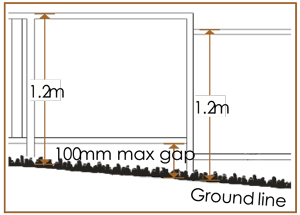
The top of the fence must be at least 1.2m above the ground at all points measured from the ground level outside the immediate pool area.
Any gaps under the fence or gate must not be larger than 100mm.
Climbable objects
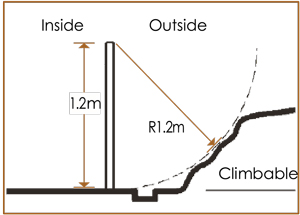
The 1.2m rule also applies to how close any climbable object must be away from the fence.
This means that there must be no trees, hedges, or stacks of wood etc within 1200mm of the outside of the fence.
Horizontal and vertical spacing
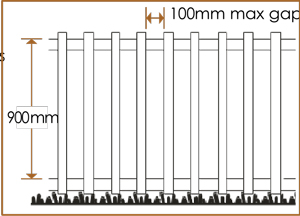
Any gaps between vertical palings, pickets and posts etc, must not be wider than 100mm.
Any horizontal rails, supports, or rods that are accessible from the outside, must be at least 900mm apart.
Construction requirements for gates and door, they must:
* Close and latch automatically when released from any point.
* Be durable and designed to prevent climbing.
* Minimum of 1200 mm (1.2m) high and have maximum gap of 100mm between verticals and at the base.
* Open away from the pool – so if the gate is left unlatched, it will not open if a young child leans against it.
* Be clear of anything that could prevent them from closing, and have no means of being held open.
* Not open when lifted up or pulled down, they must not release from the latch, come off the hinges or provide clearance of more than 100mm.
Doors shall be single, leave no more than one metre in width. Doors can be side hinged or sliding.
Please read New Zealand Building Code Clause F9 section 4.2 to check all the fine points required for compliance or contact our building staff for advice.
Security and locking requirements
Reliable operation of a self-closing and latching gate or door is critical to pool safety.
Every gate and door must have a device which will automatically close and latch to ensure it can’t be accidentally left open.
Where the latch is on the outside of the fence, it must be at least 1.5 metres above the ground.
Please note: gates and doors under F9 must close from any position, there are a variety of new requirements including installing audible door alarms in some cases.
We recommend discussing these rules with our building team to make sure your pool barrier is complaint.
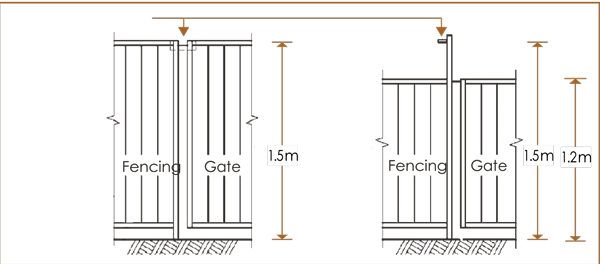
Fence materials
Brick or block walls must not be climbable.
Mesh fences are permitted provided the mesh is smaller than 10mm or the fence is 1.8m high, no smaller than 50mm.
Garden features such as a change in level can provide the required barrier but care must also be given for safety from falling.
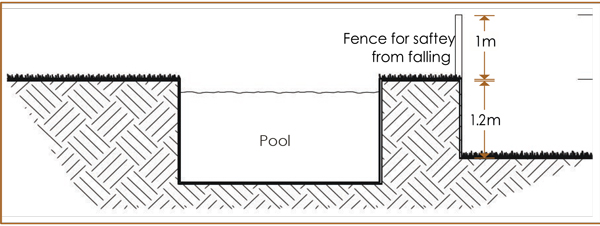
Note: Pools installed after 1 January 2017 are required to meet the requirements on the Ministry of Building, Innovation and Employment website
Chemicals in pool water can be harmful to the environment, so your pool water shouldn't be drained into streams or rivers.
In urban areas drain pool water to the sewer through a gully trap, not to a stormwater drain.
In rural areas drain pool water into a soak pit or on to land.
If your property has a septic tank, its location must be shown on the swimming pool application. This is to make sure it’s not in close proximity or affected by backwash from the pool.
When pools are filled or topped up, a backflow prevention device (vacuum breaker) must be used so the pool water can't siphon back into the drinking water supply. This applies to both tank water supply and city water supply.
Most pools are filled from a hose, so that makes it easy to fit a backflow device to the tap as a permanent fixture. These are available at a hardware or plumbing stockist.
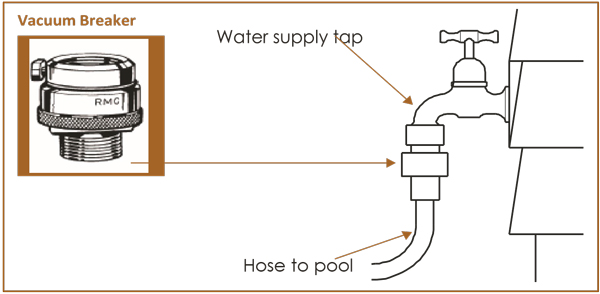
Do all pools need to be fenced?
Residential pools that are filled or partly filled with water must have physical barriers that restrict access to the pool by unsupervised children under 5-years-of-age.
The safety barrier must meet the standards in the Act, regardless of when the pool was installed.
There are different requirements for pools that are consented, or first come to the attention of Council after 1 January 2017
Indoor pools
The Fencing of Swimming Pools Act did not apply to pools wholly enclosed inside a house. However, young children are at risk if they have unrestricted access to pools in the home environment. Existing and new indoor pools are now subject to the same barrier requirements as other residential pools. For example, doors to the pool room must not be able to be readily opened by children and would need to be self-closing or have an alarm.
Spa pools
Some spa pools are exempt from the Building Act fencing requirements under Exemption 21A of Schedule 1 of the Act - Means of restricting access to small heated pools.
This applies to spa pools that have a water surface area of 5 square metres or less, the top surface is at least 760mm above the floor, deck or ground, and it has a compliant lockable cover.
All residential pools require a barrier that meets the standards in the Act, regardless of when the pool was installed.
An existing pool that's not fenced to the standards in the Act will require a building consent. The consent is for the pool barrier only and will require inspection to check the fence and gates.
Existing pools, consented and installed before 1 January 2017 are deemed to comply with the residential pool barrier requirements if they complied with the Schedule to Fencing of Swimming Pools Act 1987.
The pool safety barrier/fence may only surround the pool and the area immediately around the pool. This pool area can only include things used in association with the pool, like a sunbathing deck or changing shed. It must not include the clothesline, barbecue area or vegetable garden. The area should have only one entry gate.
It may be possible to use a boundary fence as part of the safety barrier, however, this is subject to strict conditions.
With a boundary fence, there's a danger that a neighbour may unknowingly make the barrier unsafe, such as by stacking timber against the fence so that it becomes easy for a child to climb over.
If the boundary fence is to be part of the pool barrier please contact our building team to discuss the specific requirements that apply.
Yes, but you have to meet certain requirements of the Act. Please check with our building team for the requirements. If I use the boundary fence as part of the pool fence, does my neighbour have to share the cost?
The Fencing Act 1978 sets out you and your neighbour’s obligations for constructing a fence between your properties. Read the information on the fencing law – what you should know.
If you intend to use the boundary fence as part of your swimming pool fence, you're responsible for the construction and maintenance of a compliant safety barrier.
- Pool owners and people with pools on their property including tenants, have duties under the Act.
- Pool owners must tell Council that they have a pool.
- Anyone intending to install a pool must inform Council. A building consent is required before constructing any pool and may also be required if altering a fence around an existing pool.
It’s illegal to have an unfenced pool - owners may be prosecuted.
Criminal charges can be brought against any person in control of a property where a child drowns due to an inadequately fenced pool.
Pool safety checklist
Use this checklist at least once a year to check the safety of your pool